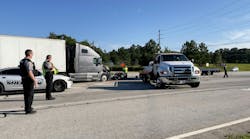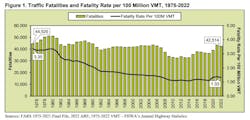Using data compiled from 2022, National Highway Traffic Safety Administration's (NHTSA) National Center for Statistics and Analysis found that fatalities from crashes involving large trucks (>10,000 lb. GVWR) increased 2% year-over-year—from 5,788 to 5,936. Since 2009, truck crash fatalities have increased 75%.
Overwhelmingly, people in other vehicles involved in these crashes took the most damage, resulting in 4,839 dead and 118,735 injured in 2022 (up 3.7% YOY).
Some troubling trends suggest driving trucks has become hazardous. The percentage of truck occupants who lost their lives in these crashes rose 8.5% and previous studies have indicated many crashes involving large trucks were caused by passenger vehicles, but the latest data suggest more truckers are involved in unforced crashes. In 2022 NHTSA data found 24% more truckers were injured in single-vehicle accidents. Thirteen percent fewer truck occupants were hurt in multi-vehicle crashes, though, resulting in a net 0.7% decrease overall.
On a positive note, total roadway deaths declined 1.7% from 2021—from 43,230 to 42,514. Roadway injuries also went down 4.6%. Furthermore, the rate of large truck crash deaths was not as pronounced as from 2020 to 2021, which saw a 17% jump. These results were impacted by the COVID-19 pandemic. The total vehicle miles traveled increased by 11% from 2020 to 2021 NHTSA estimated. The fatality rate actually went down over that time: 1.33 fatalities per 100 million VMT in 2021 versus 1.34 in 2020.
The report noted fewer occupants of other potential commercial vehicle types were killed in crashes:
- Light trucks: -0.9% YOY
- Pickups: -4.2% YOY
- Vans: -3.4% YOY
Ramifications
With wider adoption of advanced driver assistance systems to mitigate crashes, as well as rising “nuclear verdict” payouts, the trucking industry has more means and motivation than ever to lower crashes.
The government is also getting more involved. The Department of Transportation has said the amount of road fatalities and injuries “have reached crisis levels,” and U.S. Transportation Sec. Pete Buttigieg has stated he wants to bring the number of roadway deaths to zero. In 2023 the DOT announced $800 million (via the Bipartisan Infrastructure Law) worth of grants to investigate and institute strategies to reduce both.
The Federal Motor Carrier Safety Administration has also moved forward with two major rule changes set to impact trucking. These include mandates that would require trucks utilize speed limiter and automatic emergency braking technologies.
Read more: Are AEB and speed limiter mandates the cure for trucking's crash epidemic?
As of April 2023, the Federal Motor Carrier Safety Administration (FMCSA) filed a notice of intent it was still committed to its 2016 notice of proposed rulemaking that would mandate speed-governing devices be installed on Classes 7 & 8 trucks. And it’s not the only one. Recently in Canada, British Columbia enacted its own version of a speed-limiter mandate.
NHTSA and FMCSA proposed a similar mandate for AEBs, FMVSS No. 128, Heavy Vehicle AEB, in June 2023, which would require any vehicle with a 10,000-lb. GVWR or more to feature the technology.
Safety advocacy groups have also targeted the industry as responsible for the rise in road deaths and injuries.
“The carnage on our roadways is deeply disturbing. These crashes won’t go away on their own, we need our public officials to show courage and put the needs of the public above the interests of large trucking companies,” stated Russ Swift, board co-chair of Parents Against Tired Truckers (P.A.T.T.) .
They also want to see changes now.
“I call on Secretary Buttigieg to take action and URGENTLY proceed with rulemaking to require the use of speed limiters and automatic emergency braking in large trucks as soon as possible. No one else needs to die because of bureaucratic inaction,” stated Truck Safety Coalition (TSC) Board President Tami Friedrich in a release.
The FMSCA is mulling just how to institute these rules. Limiting a truck’s speed when merging onto the highway, for example, creates its own risks.
“Forcing trucks to speeds below the flow of traffic increases interactions between vehicles and leads to more crashes,” said OOIDA President Todd Spencer in 2023.
The group has pushed for more truck parking and sensible Hours of Service regulations.
Options beyond mandates
Many fleets already implement AEB and speed limiters. According to NHTSA’s Preliminary Regulatory Impact Analysis for FMVSS No. 128, AEBs have a 50% projected installation rate for MY 2024 Classes 7-8 trucks.
More have found dash cams as a method to not only discern if their truck or a another vehicle are at fault in an accident, but also can use accidents and risky behavior to coach drivers to practice safer driving.
“One of our fleets posts drive cam videos in their discussions, and then the drivers communicate what they would have done differently or how they would have coached the driver in that situation,” explained Dr. Gina Anderson, CEO and co-founder of Luma Brighter Learning, an online fleet education company. In a company-hosted study with Dart Transit Company, Luma Brighter Learning stated that drivers who completed more of their eNugget trainings received better safety scores.
With these, management can coach drivers before an accident occurs. In Motive’s first State of Safety Report, the company stated that 53% of 1,110 fleets reported fewer accidents with driver coaching.
While the roads may not be safe according to NHTSA, it is safe to say that commercial trucking has options when it comes to making them safer. And more are likely to come as the industry develops, which could lead to fewer fatalities in the future.






